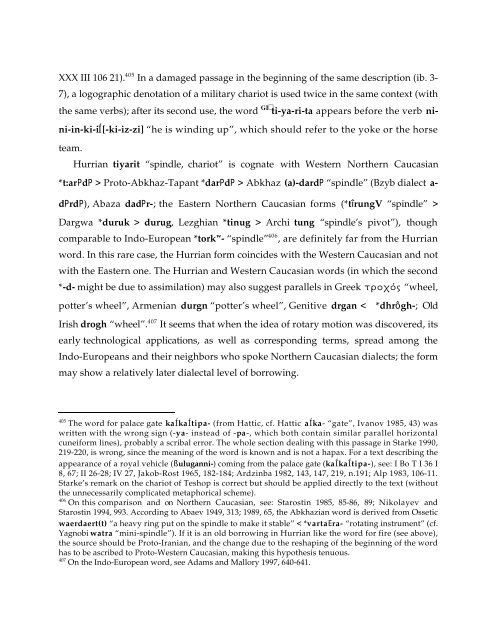Comparative Notes on Hurro-Urartian, Northern Caucasian
Comparative Notes on Hurro-Urartian, Northern Caucasian
Comparative Notes on Hurro-Urartian, Northern Caucasian
You also want an ePaper? Increase the reach of your titles
YUMPU automatically turns print PDFs into web optimized ePapers that Google loves.
XXX III 106 21). 405 In a damaged passage in the beginning of the same descripti<strong>on</strong> (ib. 3-<br />
7), a logographic denotati<strong>on</strong> of a military chariot is used twice in the same c<strong>on</strong>text (with<br />
the same verbs); after its sec<strong>on</strong>d use, the word ti-ya-ri-ta appears before the verb ni-<br />
ni-in-ki-iÍ[-ki-iz-zi] “he is winding up”, which should refer to the yoke or the horse<br />
team.<br />
Hurrian tiyarit “spindle, chariot” is cognate with Western <strong>Northern</strong> <strong>Caucasian</strong><br />
*t:arPdP > Proto-Abkhaz-Tapant *darPdP > Abkhaz (a)-dardP “spindle” (Bzyb dialect a-<br />
dPrdP), Abaza dadPr-; the Eastern <strong>Northern</strong> <strong>Caucasian</strong> forms (*tîrungV “spindle” ><br />
Dargwa *duruk > durug, Lezghian *tinug > Archi tung “spindle’s pivot”), though<br />
comparable to Indo-European *tork w - “spindle” 406 , are definitely far from the Hurrian<br />
word. In this rare case, the Hurrian form coincides with the Western <strong>Caucasian</strong> and not<br />
with the Eastern <strong>on</strong>e. The Hurrian and Western <strong>Caucasian</strong> words (in which the sec<strong>on</strong>d<br />
*-d- might be due to assimilati<strong>on</strong>) may also suggest parallels in Greek troxÒw “wheel,<br />
potter’s wheel”, Armenian durgn “potter’s wheel”, Genitive drgan < *dhrôgh-; Old<br />
Irish drogh “wheel”. 407 It seems that when the idea of rotary moti<strong>on</strong> was discovered, its<br />
early technological applicati<strong>on</strong>s, as well as corresp<strong>on</strong>ding terms, spread am<strong>on</strong>g the<br />
Indo-Europeans and their neighbors who spoke <strong>Northern</strong> <strong>Caucasian</strong> dialects; the form<br />
may show a relatively later dialectal level of borrowing.<br />
405 The word for palace gate kaÍkaÍtipa- (from Hattic, cf. Hattic aÍka- “gate”, Ivanov 1985, 43) was<br />
written with the wr<strong>on</strong>g sign (-ya- instead of -pa-, which both c<strong>on</strong>tain similar parallel horiz<strong>on</strong>tal<br />
cuneiform lines), probably a scribal error. The whole secti<strong>on</strong> dealing with this passage in Starke 1990,<br />
219-220, is wr<strong>on</strong>g, since the meaning of the word is known and is not a hapax. For a text describing the<br />
appearance of a royal vehicle (ßuluganni-) coming from the palace gate (kaÍkaÍtipa-), see: I Bo T I 36 I<br />
8, 67; II 26-28; IV 27, Jakob-Rost 1965, 182-184; Ardzinba 1982, 143, 147, 219, n.191; Alp 1983, 106-11.<br />
Starke’s remark <strong>on</strong> the chariot of Teshop is correct but should be applied directly to the text (without<br />
the unnecessarily complicated metaphorical scheme).<br />
406 On this comparis<strong>on</strong> and <strong>on</strong> <strong>Northern</strong> <strong>Caucasian</strong>, see: Starostin 1985, 85-86, 89; Nikolayev and<br />
Starostin 1994, 993. According to Abaev 1949, 313; 1989, 65, the Abkhazian word is derived from Ossetic<br />
waerdaert(t) “a heavy ring put <strong>on</strong> the spindle to make it stable” < *vartaEra- “rotating instrument” (cf.<br />
Yagnobi watra “mini-spindle”). If it is an old borrowing in Hurrian like the word for fire (see above),<br />
the source should be Proto-Iranian, and the change due to the reshaping of the beginning of the word<br />
has to be ascribed to Proto-Western <strong>Caucasian</strong>, making this hypothesis tenuous.<br />
407 On the Indo-European word, see Adams and Mallory 1997, 640-641.





